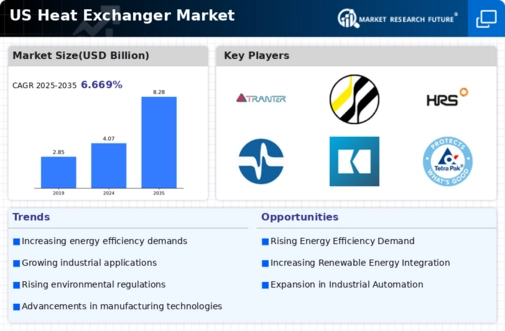Increasing Demand for HVAC Systems
The rising demand for HVAC systems in residential, commercial, and industrial sectors is a significant driver for the heat exchanger market. As climate control becomes increasingly essential for comfort and productivity, the need for efficient heat exchangers in HVAC applications is growing. The heat exchanger market is projected to expand as manufacturers develop systems that not only meet regulatory standards but also cater to consumer preferences for energy-efficient solutions. The HVAC market in the US is expected to reach $100 billion by 2027, indicating a strong correlation with the demand for heat exchangers, which are integral components of these systems.
Rising Energy Efficiency Standards
The heat exchanger market is experiencing a notable shift due to the increasing energy efficiency standards mandated by regulatory bodies in the US. These standards aim to reduce energy consumption across various sectors, including HVAC, power generation, and manufacturing. As a result, manufacturers are compelled to innovate and produce heat exchangers that meet or exceed these efficiency benchmarks. The market is projected to grow at a CAGR of approximately 6.5% from 2025 to 2030, driven by the demand for energy-efficient solutions. This trend not only enhances operational efficiency but also aligns with the broader goals of reducing greenhouse gas emissions, thereby influencing the heat exchanger market significantly.
Expansion of Renewable Energy Sources
The ongoing expansion of renewable energy sources in the US is a critical driver for the heat exchanger market. As the country transitions towards cleaner energy, technologies such as solar and wind power require efficient heat exchange systems to optimize energy conversion and storage. The heat exchanger market is likely to benefit from this shift, as these systems are essential for maintaining optimal operating temperatures and improving overall system efficiency. The investment in renewable energy infrastructure is expected to reach $500 billion by 2030, further propelling the demand for advanced heat exchangers tailored for these applications.
Technological Innovations in Heat Transfer
Technological innovations in heat transfer mechanisms are significantly influencing the heat exchanger market. Advancements in materials science, such as the development of high-performance alloys and composites, are enabling the production of more efficient and durable heat exchangers. These innovations are crucial for industries that require precise temperature control and energy efficiency. The heat exchanger market is likely to see an increase in demand for these advanced systems, as they offer improved performance and longevity. Furthermore, the integration of smart technologies, such as IoT-enabled monitoring systems, is expected to enhance operational efficiency and predictive maintenance, further driving market growth.
Industrial Growth and Infrastructure Development
The heat exchanger market is poised for growth due to the robust industrial expansion and infrastructure development occurring in the US. Sectors such as oil and gas, chemical processing, and food and beverage are witnessing increased investments, necessitating efficient heat management solutions. The heat exchanger market is projected to see a surge in demand as industries seek to enhance productivity and reduce operational costs. With the US government investing heavily in infrastructure projects, the market could experience a growth rate of around 5% annually, driven by the need for reliable and efficient heat exchangers in various applications.


















Leave a Comment